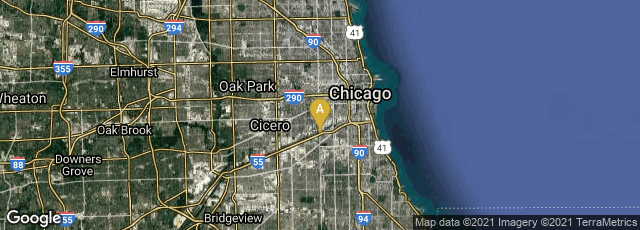

A: Chicago, Illinois, United States
"The first half of the 19th century brought dramatic changes in transportation and communications to the U.S. The introduction of the railroad and the telegraph greatly accelerated the transmission and dissemination of information. At the same time, the demographic structure of the country was changing rapidly, with the population spreading to the West and concentrating in cities. These changes both increased the demand for newspapers and facilitated their production. In 1800 there were 200 newspapers being published in the United States. By 1860 there were 3000.1 Many of the new urban papers that were founded in the 1830s and 40s reached unprecedented circulation numbers. According to one estimate, the total annual circulation of all newspapers between 1828 and 1840 doubled from 68 million to 148 million copies.2 Some scholars also speculate that this expansion of the press was due to increased political participation of the working and middle classes, higher rates of literacy, and increased leisure time.3 Advances in printing technology, such as the Fourdrinier paper-making machine and steam printing presses, were equally important, since they allowed for newspapers to be printed faster and more efficiently.
"At the beginning of the century, journalism in cities was dominated by the political and mercantile press, which tended to cater to particular groups of elite readers. But the 1820s and 30s saw the establishment of many new papers intended specifically for working men, free blacks, women, immigrants, and Native Americans, as well as for particular religious denominations, professions, or political causes like abolition and temperance. In this video, we will focus on one of the most significant developments in journalism of this period—the penny paper. These one-cent daily newspapers that began appearing in the 1830s were cheaper than the six-cent mercantile and political papers that preceded them, and they sought a new mass audience of middle and working-class readers. They proclaimed their political independence and strove to entertain their readers. They did not invent cheap pricing, the idea of political independence, or sensational reporting, but they took these elements of early American journalism and combined them in a new way. In doing so, they became some of the most successful and influential papers of the nineteenth century.
"These new penny papers combined major innovations in pricing, distribution, format, and content. Instead of being subsidized by political parties, they began operating independently and targeting new audiences. Instead of merely reprinting foreign news or speeches, they expanded coverage to local news, human interest stories, court reports, and scandals. Partisan papers charged higher prices and also received extra support from political patrons or government printing contracts. Because the penny papers were cheaper and generally didn't receive outside help, they depended more on advertising revenue, which was tied to circulation rates. The shift in the business model from offering expensive yearly subscriptions to vending individual copies by newsboys meant that the audience for these papers now included any literate person who happened to be walking down the street. Although the penny papers continued to report on "serious" subjects like politics and finance, the choice of content was not driven by party affiliation, but rather by what would sell the most papers. Benjamin Day, who got his start in the working class press, founded the New York Sun in 1833, but its motto--"It Shines for All"--also indicates that he intended to reach a wider audience not limited to any particular group. With only 3 columns, the Sun’s early issues were about half as wide and half as tall as the typical political or mercantile papers. The Sun first popularized publishing police and court reports, which consisted of short descriptions of arrests for drunkenness, theft, and violence. Popular stories like these, delivered in brief paragraphs in a direct style, proved to be an enormous success. The Sun's example was widely copied by competitors. As many as 35 penny papers were founded in New York during the 1830s, but only two--Benjamin Day's New York Sun and James Gordon Bennett’s New York Herald--managed to survive the decade.4
"Bennett was one of the most colorful figures of American journalism, and his Herald attempted to surpass the Sun in its sensationalism. The Herald also pioneered the use of specialized columns and sections for financial news, sports, and local, state, and national news. Since the Herald and the Sun soon became major rivals, the two editors often attacked each others' papers, citing errors, delays, and dullness, while proclaiming the superiority of their own publication. Although they claimed political independence, the penny papers were certainly biased, and, like the partisan papers of the 1820s, their content was strongly associated with the personality of the editor. Bennett was especially outspoken. For example, in this column from October of 1835, he taunted the Sun, casting aspersions on its success and reputation.
1. Frank Luther Mott, American Journalism: A History of Newspapers in the United States Through 250 Years, 1690-1940 (New York: Macmillan, 1941), 216.
2. Dan Schiller, Objectivity and the News: The Public and the Rise of Commercial Journalism (Philadelphia: University of Pennsylvania Press, 1981), 12.
3. Michael Schudson, Discovering the news: A Social History of American Newspapers (New York: Basic Books, 1978), 35-39, 43-50; and Schiller,Objectivity, 15-17.
4. William Huntzicker, The Popular Press, 1833-1865 (Westport, CT: Greenwood Press, 1999), 32." (http://www.library.illinois.edu/hpnl/guides/newspapers/american/1800-1860/city.html, accessed 02-27-2015).